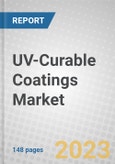The scope of the report includes a general outlook of the UV-curable coatings market. It examines industry standards, government and industry support, and other key factors related to the success of UV-curable coatings. This report segments the market into four major sub-segments: end use, type, composition, and region.
The material type explains the relevant and upcoming technologies covering the qualitative aspects of the market in broad detail. A detailed overview of these technologies coupled with relevant market data in terms of market size measured in dollar terms are provided. The scope of the report covers the overview of the global market for UV-curable coatings and an analysis of the global market trends, with the historic year 2021 and estimates for 2023 and 2028 with a projection of CAGR in the forecast duration. The sales values are presented in U.S. dollars. Estimated values used are based on manufacturers' total revenues.
The study also discusses the market dynamics such as drivers, restraints, opportunities, and challenges. It also examines new and emerging trends and their impact on current and future market dynamics.
Report Includes
- 33 data tables and 25 additional tables
- An overview of the global markets and technologies for UV curable coatings
- Estimates of the market size and analyses of market trends, with data from 2022, estimates for 2023 and projections of compound annual growth rates (CAGRs) through 2028
- Quantification of the market potential for UV curable coatings based on composition, end user and region
- Coverage of technical and commercial developments in the UV curable coatings industry, and an assessment of the emerging technologies
- Insight into the government regulations of paints and coatings industry, technology advancement undertaken by key players, and ESG implementation, and discussion on importance of ESG in the UV-Curable coatings market
- Analysis of patent activity, and a look into the recent industry structure, current competitive scenario, R&D activities, and legislative issues currently focused on the UV-Curable coatings market
- Market share analysis of the key companies of the industry and coverage of their proprietary technologies, strategic alliances, and other key market strategies
- Company profiles of major players within the industry, including Akzo Nobel N.V., BASF SE, PPG Industries Inc., The Dow Chemical Company, and Sherwin-Williams Company
Table of Contents
Executive Summary
The need for UV coatings is expanding significantly, driven by rising environmental consciousness, advancements in the coatings, and the constant introduction of new component technologies. UV coatings are are environmentally friendly because they are made of 100% curable compositions. That excludes the drying process, which excludes solvent evaporation. Reactive monomers and photoinitiators are found in UV formulations, which cure when exposed to UV radiation. Due to its ability to lower the amount of volatile organic compounds (VOCs) emitted during the drying process, UV has replaced several solvent-based applications. Traditional solvent-based coatings emit organic compounds into the atmosphere, which can be dangerous for both the environment and the health of the personnel applying the coatings. UV coatings are frequently chosen from an environmental standpoint since they don't release any volatile organic compounds and require little energy to dry. Formulators are considering changing their solvents or switching to UV-curable inks and coatings, and they are becoming increasingly popular in light of these reasons and VOC regulation compliance.
This report has been segmented based on composition, end-use industry, and region.
In terms of composition, UV-cured coating formulations include oligomers, monomers, photoinitiators, and others. A significant amount of the market is comprised of monomers. The monomers are low-volatility, non-flammable, and odorless substances. The number of functional groups a monomer has influences the attributes it contributes to the UV formulation. Monomers typically have one to six UV-curable groups. These monomers are simple multifunctional or monofunctional polyols and low-viscosity materials, most frequently esters of acrylic acid. Typically, acrylic functional groups are used to choose monomers. The COVID-19 pandemic, however, caused supply chain disruptions that resulted in a decline in UV-curable coating sales. This demand would increase significantly with the resurgence of the electronics, industrial coatings, and graphic arts industries.
In terms of value, oligomers make up a significant portion of composition type. These materials are created using various backbone-building chemistries, including polyester acrylates, epoxy acrylates, urethane acrylates, and acrylic acrylates. Oligomers provide most fundamental characteristics of the UV curing formulation. The type of oligomers utilized in the chemical formulation plays a significant role in determining the general characteristics of printing inks, adhesives, coatings, and binders cross-linked by radiant energy. Oligomers are a feasible option for UV-curable resins for many end uses, including wood flooring, kitchen cabinets, and furniture, and are expanding quickly. Oligomers are also utilized in coatings for high-end and mid-range priced furniture, ski and snowboard coatings, and durable and hardwood flooring. Urethane acrylates provide a high-end performance with few process difficulties and almost no VOC emission. Aluminum extrusions, office furniture, appliances, industrial equipment, containers, and numerous other OEM applications use 100% solids UV formulations. High solids coatings, made of two components of polyurethane, cure at lower temperatures than baking systems, which saves energy.
Companies Mentioned
- Actega Schmid Rhyner AG
- Akzo Nobel N.V.
- Ashland Global Holdings Inc.
- Axalta Coating Systems Ltd.
- Basf Se
- Brilliant Coating Solutions
- Croda International plc
- Deutsche Druckfarben
- Dic Corp.
- Dymax Corp.
- Eternal Materials Co. Ltd.
- Huizhou Changrunfa Paint Co. Ltd
- Jainco Industry Chemicals
- Phichem Corp.
- Ppg Industries, Inc.
- Soltech Ltd
- Teknos Group Oy
- The Dow Chemical Company
- Sherwin-Williams Company
Table Information
| Report Attribute | Details |
|---|---|
| No. of Pages | 148 |
| Published | October 2023 |
| Forecast Period | 2023 - 2028 |
| Estimated Market Value ( USD | $ 8.2 Billion |
| Forecasted Market Value ( USD | $ 13.1 Billion |
| Compound Annual Growth Rate | 9.6% |
| Regions Covered | Global |
| No. of Companies Mentioned | 19 |









